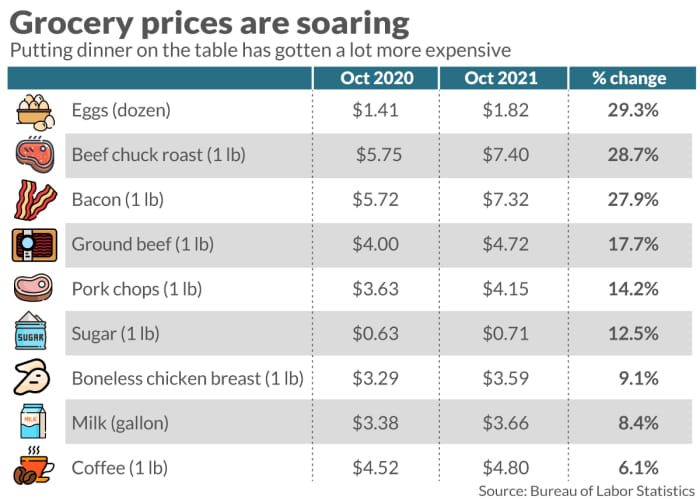This post was originally published on this site
To prepare for Thanksgiving, millions of Americans flock to grocery stores or watch YouTube
GOOG,
GOOGL,
videos on the art of turkey carving.
But amid a mixed economic recovery, millions of Americans are worried about not having any food on their plates this Thanksgiving — let alone a turkey.
Almost 4 million fewer Americans are unemployed leading up to Thanksgiving this year compared to last year. And new unemployment claims last week dropped to 199,000 — the lowest level of initial claims since November 1969.
Yet nearly 20 million American households sometimes or often didn’t have enough food to eat from Sept. 29 to Oct.11, according to the U.S. Census Bureau’s Household Pulse survey conducted then.
“From June 2020 to August 2021 federal SNAP spending increased from $7.6 billion to $10.4 billion — a 37% jump. Over the same timeframe, food insecurity rates dropped by 38%”
Around the same time last year, about 22.7 million households had recently experienced insecurity, according to a Household Pulse survey conducted from Sept. 30 to Oct. 12, 2020.
The drop in household food insecurity rates from a year ago has a lot to do with increased federal spending on Supplemental Nutrition Assistance Program (SNAP) benefits (also called food stamps) and stimulus aid such as direct relief checks and enhanced unemployment benefits, according to a report published Wednesday by Hunger Free America, a nonprofit.
From June 2020 to August 2021 federal SNAP spending increased from $7.6 billion to $10.4 billion — a 37% jump. Over the same timeframe, food insecurity rates dropped by 38%.
But rates started to tick up in October as a result of pandemic stimulus programs expiring, the report suggested.
That same month the U.S. Department of Agriculture’s historic SNAP benefit increase, which the agency announced in August, took effect. Some 42 million Americans who receive SNAP benefits started receiving what works out to be a $157 increase in food benefits on average each month, a $36 monthly increase from before the pandemic, according to the USDA.
Food insecurity takes a toll on older Americans
Americans older than 65 are getting hit hardest. They were the only adult age group that experienced higher rates of food insecurity this October compared to last year, according to Census data.
Increasing food costs are partly to blame for the higher rates among Americans 65 or older, said Jenny Young, vice president of communications at Meals on Wheels, a national nonprofit group that delivers food and provides support to seniors.

Grocery prices are up 5.4% compared to last year — one of the biggest increases in the past two decades, according to the Consumer Price Index. Meat, chicken, dairy, eggs, sugar and coffee are among the products that have seen especially large price gains in the past year.
On top of this, supply chain issues are making it harder for seniors to get the foods they want.
“Grocery prices are up 5.4% compared to last year — one of the biggest increases in the past two decades, according to the consumer price index”
“Not only do these disruptions and increases directly hit the wallets of vulnerable older adults, but the community-based programs which they turn are also feeling a significant strain as well,” Young told MarketWatch.
“These increased costs have direct consequences on budgets and the number of meals and individuals they’re able to serve,” she said, referring to the 5,000+ community-based Meals on Wheels programs in the U.S.
As of July 2021, the most recent month Meals on Wheels has program data for, a majority of these programs were still serving an average of 57% more meals weekly than they were before the pandemic began.
“‘These increased costs have direct consequences on budgets and the number of meals and individuals they’re able to serve’”
Nearly half (48%) of programs said they wouldn’t be able to support their current client base without outside funding besides their usual sources.
Don’t miss: American families throw out $1,500 in uneaten food every year — how to reduce waste this Thanksgiving
And also: 10 ways you can help other people this Thanksgiving: ‘There is always a need for food assistance’

